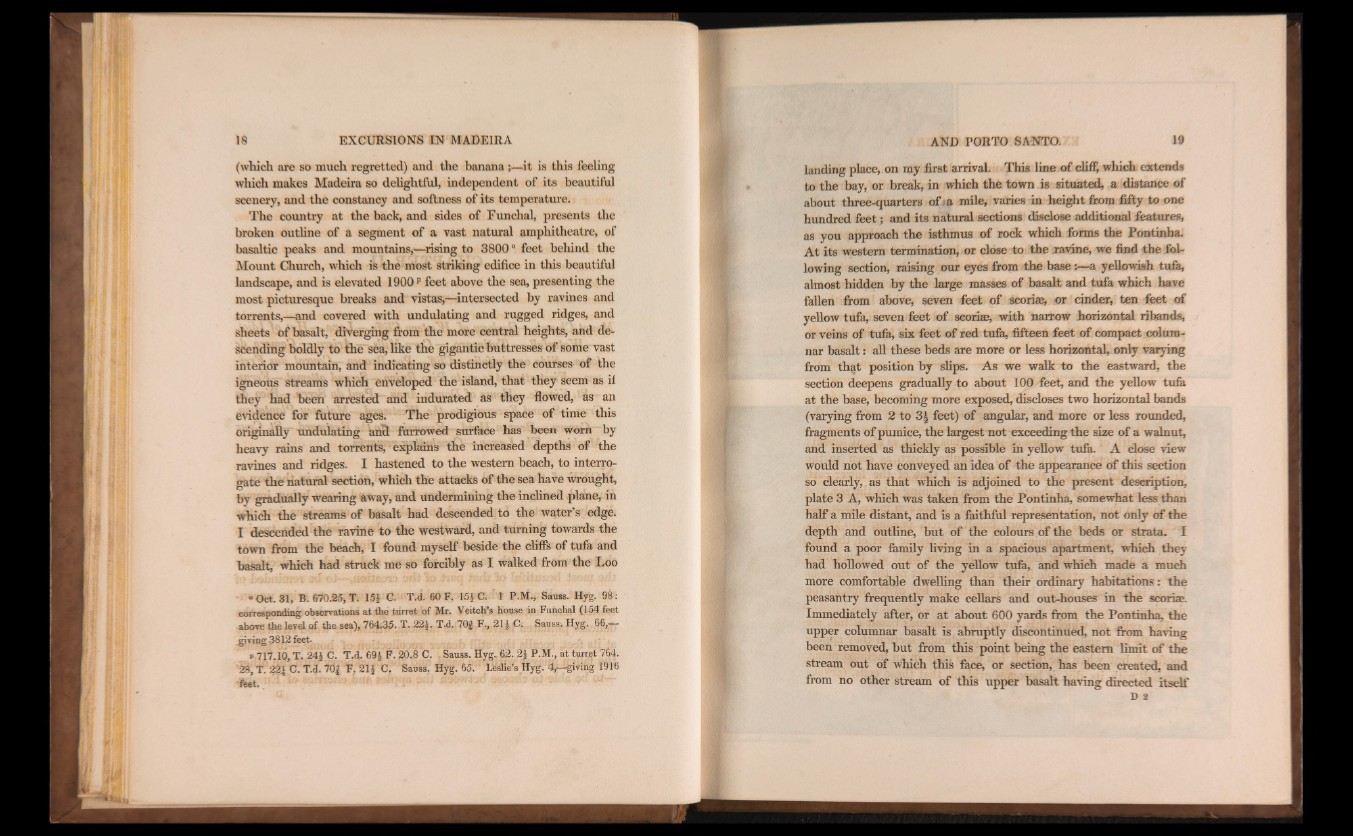
(which are so much regretted) and the banana;—it is this feeling
which makes Madeira so delightful, independent of its beautiful
scenery, and the constancy and softness of its temperature.
The country at the back, and sides of Funchal, presents the
broken outline of a segment of a vast natural amphitheatre, of
basaltic peaks and mountains,—rising to 38000 feet behind the
Mount Church, which is the most striking edifice in this beautiful
landscape, and is elevated 1900p feet above the sea, presenting the
most picturesque breaks and vistas,—intersected by ravines and
torrents,—and covered with undulating and rugged ridges, and
sheets of basalt, diverging from the more central heights, and descending
boldly to the sea, like the gigantic buttresses of some vast
interior mountain, and indicating so distinctly the courses of the
igneous streams which enveloped the island, that they seem as il
they had been arrested and indurated as they flowed, as an
evidence for future ages. The prodigious space of time this
originally undulating arid furrowed surface has been worn by
heavy rains and torrents, explains the increased depths of the
ravines and ridges. I hastened to the western beach, to interrogate
the natural section, which the attacks of the sea have wrought,
by gradually wearing away, and undermining the inclined plane, in
which the streams of basalt had descended to the water’s edge.
I descended the ravine to the westward, and turning towards the
town from the beach, I found myself beside the cliffs of tufa and
basalt, which had struck me so forcibly as I walked from the Loo
•Oct. 31, B. 670.25, T. 151 c - T.d. 60 F. 151 C. 1 PM-> Sauss. Hyg. 98:
corresponding observations at the turret of Mr. Veitch’s house in Funchal (154 feet
above the level of the sea), 764.35. T. 22J. T*d. 70§ F., 2110: Sauss; Hyg. 66,—
giving 3812 feet-
P 717.10, T. 24J C. T.d. 691 P. 20.8 C. . Sauss. Hyg. 62. 21 P.M., at turret 764.
-28, T. 221 C. T.d. 70j F. 211 C. Sauss. Hyg. 65. Leslie’s Hyg. 4,—giving 1916
feet.
landing place, on my first arrival. This line of cliff which extends
to the bay, or break, in which the town is situated, a distance of
about three-quarters of ¡a mile, varies in height from fifty to one
hundred feet; and its natural sections disclose additional features,
as you approach the isthmus of rock which forms the Pontinha.
At its western termination, or close to the ravine, we find the following
section, raising our eyes from the base:—a yellowish tuia,
almost hidden by the large masses of basalt and tufa which have
fallen from above, seven feet of scoriae, or cinder, ten feet of
yellow tufa, seven feet of scoriae, with narrow horizontal ribands,
or veins of tufa, six feet of red tufa, fifteen feet of compact columnar
basalt: all these beds are more or less horizontal, only varying
from that position by slips. As we walk to the eastward, the
section deepens gradually to about 100 feet, and the yellow tufa
at the base, becoming more exposed, discloses two horizontal bands
(varying from 2 to 3| feet) of angular, and more or less rounded,
fragments of pumice, the largest not exceeding the size of a walnut,
and inserted as thickly as possible in yellow tufa. A close view
would not have conveyed an idea of the appearance of this section
so dearly, as that which is adjoined to the present description,
plate 3 A, which was taken from the Pontinha, somewhat less than
half a mile distant, and is a faithfid representation, not only of the
depth and outline, but of the colours of the beds or strata. I
found a poor family living in a spadous apartment, which they
had hollowed out of the yellow tufa, and which made a much
more comfortable dwelling than their ordinary habitations: the
peasantry frequently make cellars and out-houses in the scoriae.
Immediately after, or at about 600 yards from the Pontinha, the
upper columnar basalt is abruptly discontinued, not from having
been removed, but from this point being the eastern limit of the
stream out of which this face, or section, has been created, and
from no other stream of this upper basalt having directed itself